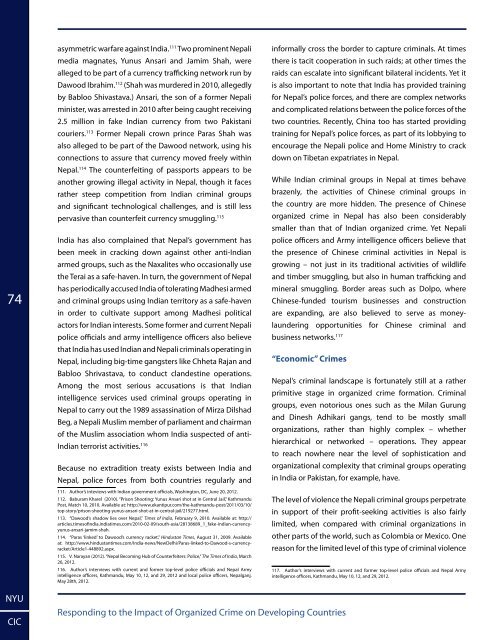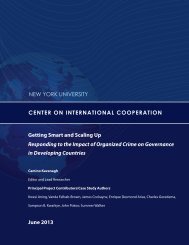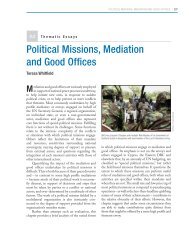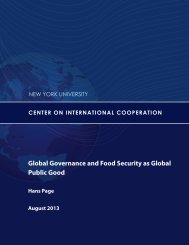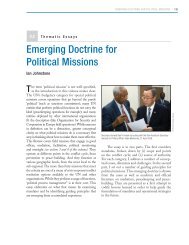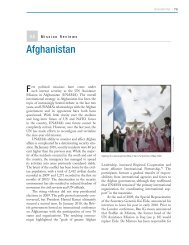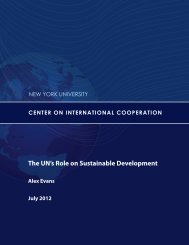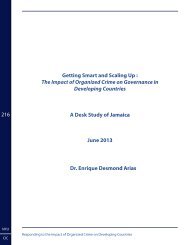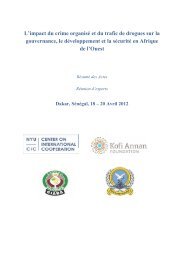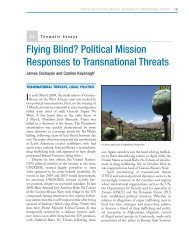here - Center on International Cooperation - New York University
here - Center on International Cooperation - New York University
here - Center on International Cooperation - New York University
Create successful ePaper yourself
Turn your PDF publications into a flip-book with our unique Google optimized e-Paper software.
74<br />
asymmetric warfare against India. 111 Two prominent Nepali<br />
media magnates, Yunus Ansari and Jamim Shah, were<br />
alleged to be part of a currency trafficking network run by<br />
Dawood Ibrahim. 112 (Shah was murdered in 2010, allegedly<br />
by Babloo Shivastava.) Ansari, the s<strong>on</strong> of a former Nepali<br />
minister, was arrested in 2010 after being caught receiving<br />
2.5 milli<strong>on</strong> in fake Indian currency from two Pakistani<br />
couriers. 113 Former Nepali crown prince Paras Shah was<br />
also alleged to be part of the Dawood network, using his<br />
c<strong>on</strong>necti<strong>on</strong>s to assure that currency moved freely within<br />
Nepal. 114 The counterfeiting of passports appears to be<br />
another growing illegal activity in Nepal, though it faces<br />
rather steep competiti<strong>on</strong> from Indian criminal groups<br />
and significant technological challenges, and is still less<br />
pervasive than counterfeit currency smuggling. 115<br />
India has also complained that Nepal’s government has<br />
been meek in cracking down against other anti-Indian<br />
armed groups, such as the Naxalites who occasi<strong>on</strong>ally use<br />
the Terai as a safe-haven. In turn, the government of Nepal<br />
has periodically accused India of tolerating Madhesi armed<br />
and criminal groups using Indian territory as a safe-haven<br />
in order to cultivate support am<strong>on</strong>g Madhesi political<br />
actors for Indian interests. Some former and current Nepali<br />
police officials and army intelligence officers also believe<br />
that India has used Indian and Nepali criminals operating in<br />
Nepal, including big-time gangsters like Chheta Rajan and<br />
Babloo Shrivastava, to c<strong>on</strong>duct clandestine operati<strong>on</strong>s.<br />
Am<strong>on</strong>g the most serious accusati<strong>on</strong>s is that Indian<br />
intelligence services used criminal groups operating in<br />
Nepal to carry out the 1989 assassinati<strong>on</strong> of Mirza Dilshad<br />
Beg, a Nepali Muslim member of parliament and chairman<br />
of the Muslim associati<strong>on</strong> whom India suspected of anti-<br />
Indian terrorist activities. 116<br />
Because no extraditi<strong>on</strong> treaty exists between India and<br />
Nepal, police forces from both countries regularly and<br />
111. Author’s inteviews with Indian government officials, Washingt<strong>on</strong>, DC, June 20, 2012.<br />
112. Baburam Kharel (2010). “Pris<strong>on</strong> Shooting: Yunus Ansari shot at in Central Jail,” Kathmandu<br />
Post, Match 10, 2010. Available at: http://www.ekantipur.com/the-kathmandu-post/2011/03/10/<br />
top-story/pris<strong>on</strong>-shooting-yunus-ansari-shot-at-in-central-jail/219277.html.<br />
113. “Dawood’s shadow lies over Nepal,” Times of India, February 9, 2010. Available at: http://<br />
articles.timesofindia.indiatimes.com/2010-02-09/south-asia/28138689_1_fake-indian-currencyyunus-ansari-jamim-shah.<br />
114. “Paras ‘linked’ to Dawood’s currency racket,” Hindustan Times, August 31, 2009. Available<br />
at: http://www.hindustantimes.com/India-news/<strong>New</strong>Delhi/Paras-linked-to-Dawood-s-currencyracket/Article1-448892.aspx.<br />
115. V. Narayan (2012). “Nepal Becoming Hub of Counterfeiters: Police,” The Times of India, March<br />
26, 2012.<br />
116. Author’s interviews with current and former top-level police officials and Nepal Army<br />
intelligence officers, Kathmandu, May 10, 12, and 29, 2012 and local police officers, Nepalganj,<br />
May 28th, 2012.<br />
informally cross the border to capture criminals. At times<br />
t<str<strong>on</strong>g>here</str<strong>on</strong>g> is tacit cooperati<strong>on</strong> in such raids; at other times the<br />
raids can escalate into significant bilateral incidents. Yet it<br />
is also important to note that India has provided training<br />
for Nepal’s police forces, and t<str<strong>on</strong>g>here</str<strong>on</strong>g> are complex networks<br />
and complicated relati<strong>on</strong>s between the police forces of the<br />
two countries. Recently, China too has started providing<br />
training for Nepal’s police forces, as part of its lobbying to<br />
encourage the Nepali police and Home Ministry to crack<br />
down <strong>on</strong> Tibetan expatriates in Nepal.<br />
While Indian criminal groups in Nepal at times behave<br />
brazenly, the activities of Chinese criminal groups in<br />
the country are more hidden. The presence of Chinese<br />
organized crime in Nepal has also been c<strong>on</strong>siderably<br />
smaller than that of Indian organized crime. Yet Nepali<br />
police officers and Army intelligence officers believe that<br />
the presence of Chinese criminal activities in Nepal is<br />
growing – not just in its traditi<strong>on</strong>al activities of wildlife<br />
and timber smuggling, but also in human trafficking and<br />
mineral smuggling. Border areas such as Dolpo, w<str<strong>on</strong>g>here</str<strong>on</strong>g><br />
Chinese-funded tourism businesses and c<strong>on</strong>structi<strong>on</strong><br />
are expanding, are also believed to serve as m<strong>on</strong>eylaundering<br />
opportunities for Chinese criminal and<br />
business networks. 117<br />
“Ec<strong>on</strong>omic” Crimes<br />
Nepal’s criminal landscape is fortunately still at a rather<br />
primitive stage in organized crime formati<strong>on</strong>. Criminal<br />
groups, even notorious <strong>on</strong>es such as the Milan Gurung<br />
and Dinesh Adhikari gangs, tend to be mostly small<br />
organizati<strong>on</strong>s, rather than highly complex – whether<br />
hierarchical or networked – operati<strong>on</strong>s. They appear<br />
to reach now<str<strong>on</strong>g>here</str<strong>on</strong>g> near the level of sophisticati<strong>on</strong> and<br />
organizati<strong>on</strong>al complexity that criminal groups operating<br />
in India or Pakistan, for example, have.<br />
The level of violence the Nepali criminal groups perpetrate<br />
in support of their profit-seeking activities is also fairly<br />
limited, when compared with criminal organizati<strong>on</strong>s in<br />
other parts of the world, such as Colombia or Mexico. One<br />
reas<strong>on</strong> for the limited level of this type of criminal violence<br />
117. Author’s interviews with current and former top-level police officials and Nepal Army<br />
intelligence officers, Kathmandu, May 10, 12, and 29, 2012.<br />
NYU<br />
CIC<br />
Resp<strong>on</strong>ding to the Impact of Organized Crime <strong>on</strong> Developing Countries


